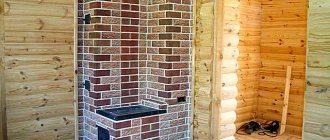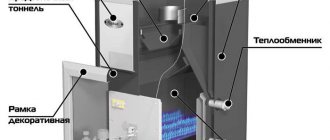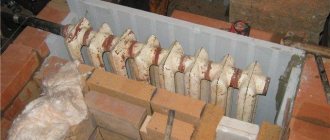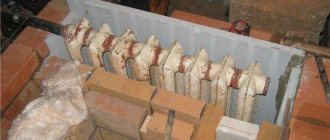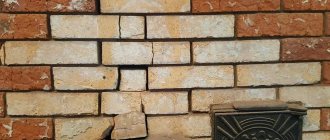Used oil is a proven fuel that can be used to heat small spaces. Recently it has become less profitable, but it is suitable for small warehouses, garages or utility blocks where fuel consumption is low.
An oil stove is an inexpensive way to heat the average garage. The material for the firebox is not difficult to find, and you can assemble it yourself in a matter of hours. It is not difficult to assemble the unit; it is made from scrap materials.
For refueling, regular motor oil is used, which can be drained from the car. Compared to expensive diesel heating devices, there is no need to buy diesel separately.
Burner or oven?
Homemade drip furnace in development
The problem of recycling used motor, transmission and hydraulic oil (waste oil) on a global scale is still far from being solved. One way to use waste is to burn it, receiving free heat. However, mining is an energy-intensive, but dirty and unstable fuel. Burners that allow the waste to be burned completely use pressurization, cleaning, dehydration and heating of the fuel, which makes them energy-dependent, technically complex and requiring qualified maintenance. Amateur craftsmen have been making exhaust furnaces with non-pressure burners for quite some time: in them, the oil burns quietly directly in the supply tank, evaporating, and the vapors enter the combustion chamber (afterburner), where they mix with secondary air and burn. Over the years of operation, mining furnaces with non-pressure burners have proven to be quite economical, but even more dangerous; comes to explosions. A drip furnace of the correct design is fireproof: evidence of this has passed accordingly. certification of industrial designs; Only domestic ones on the market include ZHAR-25 standard/automatic, semi-automatic NT 602-605, NT 612, VN-Zh-90-P/N, Teplamos T-603 (Teplon), etc. At the same time, the drip furnace is structurally simple and can be made completely non-volatile. Therefore, craftsmen are now working very closely on drip furnaces and are creating designs that are sometimes very intricate (see figure on the right). However, a good drip furnace can be made much simpler, and in terms of the efficiency of burning untreated water-flooded waste, it can come close to such a cunning device as a Babington burner.
Heat exchanger assembly
I made the stove to heat the garage. I don’t have hot water heaters in my garage, so I decided it would be better to have it immediately heated and circulate the air. If you have water batteries, then you can abandon the air heat exchanger and simply run 4-5 water coils through the upper chamber, connecting them in parallel. In this case, the design must be supplemented with a circulation pump and fan. Such equipment will allow you to heat the entire house with a stove; you just need to allocate a room for installing the stove.
Heat exchanger assembly
Let's go back to my heat exchanger. I installed it between the smoke exhaust pipe and the stove burner - this is where the heat is greatest. I welded an iron plate to the heat exchanger. Thanks to it, the flame will be held better. It will also help distribute the fire inside the stove body.
An air swirler was installed inside the heat exchanger. There are no engineering delights in such a swirler, but it copes with its task one hundred percent. When operating at maximum power, the metal of the case heats up to a scarlet color, and the heated outgoing air even penetrates the glove. You can see the swirler itself in the photo.
I'm making a swirler I'm making a swirler I'm making a swirler I'm making a swirler
Next, I took a duct fan and placed it on one side of the heat exchanger. By the way, you can connect a thermal relay to the fan for automation. This will allow you to set the temperature yourself and save resources. For example, I decided to use a thermal relay from Autonics - I just had it lying around idle. But you can also take some budget model, for example, Vemer KLIMA. I tried it too, it works great.
I supercharged it and this is what happens
Heat is concentrated in the firebox compartment.
Why working off?
Drip fuel supply is widely used in heating engineering when a heat output of approx. up to 15 kW. The principle of operation of a drip furnace is simple: liquid fuel drips into a heated evaporator, into which primary air is supplied. Each drop evaporates and partially burns immediately, maintaining the temperature of the evaporator. The remaining fuel vapors enter the combustion chamber with the influx of secondary air, where they burn completely. Thus, in drip furnaces, 2-stage fuel combustion is carried out. Unlike stoves with non-pressure burners, where the fuel heats only itself until it evaporates, in drip stoves part of the heat from the combustion of each drop is spent on heating a rather massive evaporator, which determines their lower efficiency. But there are ways to minimize this disadvantage, see below.
The maximum power of a drip furnace is largely determined by the properties of the fuel: if, in order to obtain a given amount of heat, the fuel must be released in a trickle, the furnace becomes fire and explosive. Mining in this regard is good because its viscosity and surface tension are high, i.e. It is possible to obtain frequent and large drops of waste. Diesel fuel is significantly worse in these parameters, although it is still possible to make a stove using waste fuel and diesel, see below. Drip stoves are not made with light liquid fuel - it is dangerous. Fuel oil and oil sludge are too valuable as fuel, and industrial-scale sources of heavy fuels are too stable to be burned haphazardly.
Manufacturing a horizontal heater
If you lay a standard propane cylinder horizontally and install a door at the end, you will get a fairly spacious firebox that can accommodate meter-long logs. For better heat transfer and afterburning of the resulting pyrolysis gases, you need to make a secondary chamber with partitions, as shown in the drawing.
The afterburning of combustible gases in this potbelly stove is combined with the extraction of heat from combustion products that flow around hemispherical partitions (cut out from the cylinder body). Well, an indispensable attribute of intense heat exchange - external ribs made of steel strips - are required. Practice shows that such a stove heats a garage of up to 50 m² in medium combustion mode, as described in the next video:
The heating unit is simple to manufacture: doors are installed in the front part, and a hole is cut in the back part, into which a secondary chamber from a pipe or a second cylinder is welded. In order not to take away the useful volume of the firebox, the ash pan is made hinged. If necessary, a hob is installed on top of the horizontal part.
Schemes of drip furnaces
Quite a lot of varieties of industrial devices for drip combustion of liquid fuel are known, and new patents appear regularly. But a home handyman and/or a car owner in an unheated garage shouldn’t rummage through them right away: it’s complicated, energy-dependent, and expensive.
A drip furnace, available for hobbyist construction, can be built using one of the following. circuits (see figure):
- With a wick burner (the evaporator is filled with porous filler);
- With a “wet” bowl;
- With a flame (flame) evaporator bowl and bottom fuel supply;
- The same, with top fuel supply.
Schemes of the design of drip furnaces for mining
With wick
Any potbelly stove can be adapted for a drip stove with a wick burner, because It is not the falling drops of fuel themselves that evaporate, but its reserve in the hot porous filler. To start, a little fuel is poured into the evaporator, set on fire, and when the filler warms up (as can be seen from the boiling away of the remaining kindling and the appearance of a clean flame instead of a smoking one), drops are released. The power of drip furnaces with a wick evaporator does not exceed 6-8 kW, otherwise too frequent drops cool the filler and the furnace has to be started again. If the stove is left unattended, the excess drip will cause the evaporator to overflow and fuel will leak out; possibly burning. This is a serious disadvantage of drip wick evaporator ovens. Another is that they do not have the property of self-regulation; drops for testing from different batches must be set manually each time.
Filler
The efficiency of a drip-wick stove is largely determined, firstly, by the burner filler. The ideal option is fragments of animal bones; they retain all the dirt from the fuel. Thanks to a homemade stove with a bone-filled burner, an absolutely incredible story became possible.
During Robert Scott's famous Antarctic expedition, its northern party found itself cut off from its base on the eve of the Antarctic winter. Its participants were running out of food, matches, and fuel. There was no warm clothing or salt. People dug a cave in the snow and built a grease stove from a large tin can, but it worked poorly - it barely heated and consumed a lot of seal oil (blub). Then one of them, a simple sailor whose name deserves mention - Harry Dickason - came up with the idea of filling the evaporator with seal bones. The northern party in full force (6 people) survived the winter, and in the spring, on foot, pulling a sleigh, having covered almost 600 km, they returned to the base, where they were all considered long dead. One of the participants in the northern party, Raymond Priestly, wrote a book about this “Antarctic Odyssey” (Raymond Priestly, “Antarctical Adventures.” Keep in mind that you will suddenly find yourself in an extreme situation.
The filler made from fireclay brick crumbs has similar properties. Not fireclay mortar, but finely crushed brick. With it, the drip-wick furnace develops its maximum 8 kW, because The heat capacity of fireclay is high. Broken red working brick, moderately annealed brick, is somewhat worse, because less porous, and burnt iron ore bricks and clinker are not suitable. But any filler of an evaporative wick burner is quickly poisoned by dirt from the fuel, and it must be changed regularly.
Frame
The configuration of the body of a drip-wick stove does not greatly affect its efficiency: such a stove made from a potbelly stove will be very voracious. The ideal option here is an industrial gas cylinder, for example, oxygen; under a high, strongly convex arch, fuel vapors successfully burn out before exiting into the chimney. A drip stove made from an industrial gas cylinder is well suited for a garage due to its compactness. The outlet to the chimney (diameter 100 mm; height from 4 m) is made at a level of approx. 2/3 of the height of the cylinder. Leave 120-150 mm under the burner. At a level of 60-80 mm below its bottom, 12-16 holes with a diameter of 10 mm are drilled in a circle in the cylinder for air access, this is instead of a blower (the fire door must close tightly). A threaded hole is made in the bottom of the cylinder for a plug to drain condensate.
Note: the bowl and fuel supply system are the same as those of other drip stoves, see below.
With a wet bowl
For a wet bowl drip furnace to operate successfully, a pool of oil must be burning in its evaporator. In essence, it turns out to be a small stove with a gravity burner, fed drop by drop, releasing vapor into a large afterburner. However, its efficiency is worse, because part of the secondary air (entrained by the flame in the bowl) slips into the chimney, carrying oil vapor with it. Whether the chimney is on top or on the side does not matter in this case. In addition, primary air flows around the evaporator bowl, cooling it.
The advantage of this furnace is some ability for self-regulation. If the flame in the bowl gets too hot, it will also reduce the flow of secondary air into the afterburner. Since quiet burning of oil in a bowl requires little air, the flow of primary oil will decrease and the flame will subside. But the limits of self-regulation are small, and when switching to testing from another batch, the dropper (see below) needs to be reconfigured.
Homemade drip stove with forced circulation air heating circuit
Another advantage of this furnace is the ability to integrate a horizontal air heat exchanger into it. The stove, pressurized by the air heating circuit from a low-power fan, turns into a heater (see figure on the right). Unfortunately, a vertical non-volatile heat exchanger with natural circulation cannot be installed: it will disrupt the afterburning process, and the furnace will soon become overgrown with carbon deposits (coked).
And finally, the optimal size and shape for an 8-10 kW oven of this type is a 50 liter household gas cylinder. Due to these advantages, drip furnaces with a “wet” bowl have recently become popular due to their simplicity of design.
Note: the low maximum power of furnaces with wick and wet bowl is also explained by the fact that the oil in them can evaporate in the supply tube, the end of which is located close to the flame. The vapors will evaporate into the afterburner and burn, there will be nothing left to heat the bowl, and the stove will go out.
With a flaming bowl
The most economical and safest type is a drip-type furnace with a flame bowl. The features of its structure and operation are as follows:
- Air is supplied from above through air duct B, which passes vertically through combustion chamber K.
- Secondary air (although physically in this case it is primary) is immediately taken away by fuel vapor for afterburning.
- Primary air (physically secondary) enters directly into the fuel flame in the evaporator, bypassing the bowl.
- Fuel vapor enters the combustion chamber through the annular gaps in the diaphragm D.
- It is possible to supply fuel from above through a supply tube located coaxially in the air duct, which eliminates premature evaporation of the fuel.
Thanks to these features, drip furnaces are, firstly, self-regulating: the evaporator got too hot - more vapor was spent on afterburning - less air got into the bowl - the furnace returned to mode. Secondly, it is less sensitive to the properties of the fuel: if you get oil that is more fluid, the drops start to drop more often and the evaporator flares up - see above. The oil was watered - the oil vapors, being heavier, pushed the water vapors to the periphery - the water vapors went into the peripheral gap and into the chimney, without disturbing the combustion process. We filled the tank with diesel instead of oil - the fuel vapor went to afterburning through both gaps - the combustion chamber consumed more secondary air - the flame in the evaporator died down - the stove returned to mode. And thirdly, a furnace with a flame bowl and top fuel supply is capable of developing the maximum power for this class of devices, up to 15-16 kW, thanks to air cooling of the fuel supply line.
Fuel from below
A drip furnace with a flame bowl and bottom fuel supply is structurally simpler and, unlike furnaces with wick and wet bowls, is capable of developing power up to 10-12 kW due to wider self-regulation limits. An evaporation bowl can also serve simply under a stove if it is installed on a fireproof floor or on legs; in both cases, on a gasket made of asbestos or basalt cardboard with a thickness of 20 mm or more.
An assembly drawing of a drip furnace with a flame bowl and bottom fuel supply, dimensions and details for it are given in Fig. Material: pipes of different diameters. The bowl is under the stove. The peculiarity of this design is that it is not critical to the overall dimensions. When the height of the perforated part of the air duct increases from 350 to 500 mm, the furnace power increases from 6 to 9 kW. Further increasing the height of the furnace body increases its efficiency without increasing power. The oil tank is also made from a 90 mm pipe. The fuel from it is supplied to the dropper through the side pipe, and the bottom one is designed to drain the accumulated sludge.
Drawings of a drip furnace for testing with a flame bowl and bottom fuel supply
Fuel from above
The top supply of fuel to a drip furnace with a flame bowl allows it to realize the maximum possible power and efficiency. The reason is that the self-regulation range of this design, which is the largest for drip furnaces, makes it possible to organize a proportional supply of secondary air: holes in the air duct are drilled in horizontal rows, and their number in a row and, possibly, diameter are reduced in height. To ensure high efficiency of the furnace at the lowest stroke, the lower row of holes is sometimes replaced by vertical slots. In this way, an air flow into the combustion chamber is organized, exactly equal to the need for it from burning fuel vapors at different operating modes of the furnace.
Drawings of a drip furnace in production, in which the above principles are implemented, are shown in Fig. This is the same stove, just depicted differently. Excluding the chimney and the bottom of the bowl: the option on the right is designed for 40-60 W fan pressure. The efficiency of this furnace will be only 3-4% less than that of a Babington burner if it (the furnace) is equipped with an air jacket with natural circulation, thus turning it into a heater furnace. The air in the jacket, when heated, will not diverge to the sides, but will create thermal insulation, improving the conditions for burning fuel vapors. The thickness of the air layer in the jacket is 100-120 mm.
Drawings of a drip furnace with increased power and increased efficiency
From cylinders
A 50 liter household gas cylinder is also quite suitable for the body of a drip furnace for mining with a flame bowl. Moreover, its large relative width and convex arch make it possible in some cases to abandon the diaphragm, which requires extra metal, work and complicates the maintenance of the furnace. True, it will not be possible to accelerate a drip furnace from a cylinder to more than 11-12 kW, but since any furnaces in production are suitable for heating only non-residential premises, this is not so significant.
Drawings of a drip furnace from a cylinder with a flame bowl and top fuel supply for air heating are given on the left in Fig. below. Please note: the holes in the duct are narrow; There are only 3 rows of them, located far apart in height. In a wide cylinder, burning gases rise more slowly than in a pipe and therefore mix with air better, but not yet well enough. Strong streams of air shoot out from the holes in the air duct, further mixing the gases. In the bottom row, the holes are frequent, streams of air from them form something like a virtual diaphragm, which works in the same way as the steel one in pipe furnaces.
Drawings of drip furnaces for exhaust from a household gas cylinder
On the right in Fig. – drawing of a drip furnace with a water jacket from a household gas cylinder in production. Water greatly cools the combustion chamber, preventing fuel vapors from burning out properly. Therefore, here all the secondary air “splashes out” all at once into the zone of greatest concentration, at the same time forming a virtual diaphragm stretched in height from many wider and weaker streams of air. Actually, the result is no longer a virtual diaphragm, but a virtual piston of variable diameter. This is worth a slight decrease in the efficiency of the furnace compared to the previous one, but attaching a water jacket to a drip furnace without reducing its efficiency to an outrageously low level is actually a very difficult matter.
Drip boiler
On the trail. rice. Given as an example are drawings of a drip water heating boiler from the same cylinder during testing, suitable for CO with forced circulation of the coolant (in the previous case it can only be natural thermosyphon). As you can see, the whole range of measures has been applied to increase the efficiency of the drip furnace, plus thermal insulation of the bowl and jacket with basalt wool. The insulation, in turn, must be carefully isolated from fuel vapors, otherwise the boiler will quickly fail. The sources of waste are unstable, the design of the boiler is complex, and therefore this sample has not received any widespread use.
Drawings of a drip water heating boiler for testing
How to do it yourself
What you will need
In order to make a stove, you can use almost any material: either sheet iron or a gas cylinder will do, you can also use an old metal barrel or a pipe with a diameter of 200 mm. The main thing is that the wall thickness is at least 3-5mm, otherwise the body may move when fired.
It is most reliable to use a gas cylinder; it has a fairly durable body that can withstand high pressure and temperature.
Materials for construction
- Gas cylinder. A 50-liter used one will do, but with the body intact, without damage or deformation.
- Steel pipe with a diameter of 100mm, the wall must be at least 3.5mm thick. At least 2 m of it will be required, since it will be used for the production of the heat exchanger housing, burner and chimney.
- A 50mm metal equal angle corner, a little more than a meter long, will be used to make a stand, handles and other small elements.
- Steel sheet 4mm thick. It will take approximately 0.5 sq. m for the manufacture of plugs for the pallet and the bottom of the upper compartment.
- The cast iron car disk that will be inserted into the cylinder must therefore be of the appropriate diameter.
- Standard freon bottle. The used one must have a functioning needle valve - for use as a fuel reserve reservoir.
- A hose with a diameter that allows it to fit onto a 1⁄2-inch pipe will be used for the fuel supply.
- Clamps.
- Metal water pipe 0.5 m for supplying waste inside the furnace.
- Plumbing half-inch valve.
- Door hinges and fire door latch.
Scheme of operation of a drip furnace
Fuel supply
Amateur craftsmen often supply drip furnaces with single-stage fuel: an oil tank, a ball valve, and a supply tube. Firstly, this is dangerous: for convenience and safety of starting the stove, the valve must be placed closer to it. The supply tube gets quite hot when fuel is supplied from the bottom. If the heating passes through the pipe past the valve, up to which there is a solid column of fuel in the pipe, this could lead to disaster. Secondly, the fuel supply to the furnace is unstable: as the tube warms up, the drops become more frequent, because the oil thins out. If it flows in a trickle, then it is again dangerous.
The drip supply of oil to the furnace during processing should be organized according to a 2-stage scheme: main (storage) oil tank - valve - supply dropper - supply tank (tank) - free flow from it at least 60 mm from the bottom (for additional sedimentation of sludge) - working dropper. The fuel supply is opened when the kindling in the bowl (see below) is lit. While the oil drips into the tank to the level of the drain, you can slowly adjust its flow, and then it drips into the bowl drop by drop.
Scheme of safe power supply of a drip furnace from a supply tank with a safety valve and capillary
This system, however, is not completely safe. If in a hurry, out of ignorance, or simply trying to quickly warm up from the cold, open the valve too much, the consumables will immediately fill, fuel will rush into the stove, and it will throw out a tongue of fire and start spitting burning spray. It would be correct to build a drip oil supply system into the furnace with a safety float valve and a metering capillary (see figure on the right).
Since different metals are wetted by waste in different ways, and its properties vary significantly from batch to batch, the length of the capillary will need to be selected: the oil is fed under a gravitational pressure of 120-150 mm (from a suspended container) at room temperature, and the capillary is selected so that it drips more often, but with drops clearly visible to the eye. A diesel fuel drip furnace can be used from the same feeder, but the capillary will need to be taken with a clearance of 0.6-1 mm and a length 2.5-3 times longer than for mining. There is only one drawback to this scheme for supplying fuel to a drip furnace: the exhaust is dirty fuel, and the capillary will have to be cleaned periodically.
Note: if you are not lazy and make a supply tank with replaceable capillaries for different oils and diesel fuel, the stove will become multi-fuel.
Work on preparing the cylinder
Even after prolonged ventilation, condensation remains in the gas cylinder. To remove it, you need to remove the valve and gearbox and leave it in fresh air for several days.
Then a hole is drilled in the bottom of the cylinder. To prevent sparking, the drill is moistened with oil. Since it is not easy to make a hole in thick metal, it is better to start the work with a small diameter drill, and then it can be increased to 10–16 millimeters.
Next, the balloon is filled with water and drained after 24 hours. Since condensate has an unpleasant, pungent odor, it should be carefully poured away from your home. The procedure is repeated if necessary.
Starting the furnace
It has already been said implicitly that you need to start the drip furnace slowly and smoothly. Usually, for this they use a torch made from a knitting needle with a piece of foam rubber or a rag: let some drops in and place the torch. When it gets wet, they wait until a puddle drips into the bowl, light a torch, and pour oil into it.
There is a much more convenient and safer way to start a drip stove: a wad of toilet paper soaked in the same oil. They put it in a bowl, set it on fire and slowly regulate the drips, no longer worrying about kindling. Toilet paper is almost pure cellulose; it burns without leaving a residue. Tourists have been warming themselves in tents this way for a long time: the roll is inserted into a wood chip stove, poured with half a glass of alcohol (which also burns without a trace), or the whole thing, darling, and set on fire from above. A lot of heat is generated, and an insignificant amount of fluffy ash can simply be blown out. In the oven it will fly out into the chimney.
Increasing the number of pipe bends
Increasing the bends of the potbelly stove chimney
The tank at the outlet of washing machines will retain a certain amount of heat, but it will not be able to retain all the heat. A large amount of heat will continue to escape into the chimney.
Therefore, one of the improvements that provides additional heat retention is to increase the length of the outlet pipe. A long pipe running through the room, but with good exhaust, ensures the transfer of heat from its surface, which was previously lost.
Materials and tools
- several elbows that can be easily placed in the room after the potbelly stove,
- brackets for fastening pipe elbows,
- welding machine and metal processing tools.
Instructions
First you need to mark the location of the pipe. It can pass with a large number of bends and zigzags, thereby ensuring maximum heat retention, without forgetting about the loss of exhaust draft. After marking the pipe laying location, it is necessary to install pipe mounting brackets
Particular attention should be paid to the joints of pipe elbows and corners. Brackets must be made of heat-resistant materials. Lay the pipes to ensure a tight, hermetically sealed connection, and, if necessary, modify the elbows to ensure the pipe is laid along the marked route. Firmly secure the elbows in the brackets, check the working draft (burn newspaper in front of the pipe), check the tightness of the connections, connect the inlet elbow to the stove.
Cleanable
It is definitely worth remembering that the chamber where the oil is burned must be made so that it can be disassembled during operation; this is the only way to make cleaning easier. The chimney does not need horizontal sections, since they can impair draft; in addition, there should be a minimum number of inclined sections. It is preferable to make the pipe vertical.
Chimney installation
I'm making a chimney
I made the smoke exhaust structure from a 10-centimeter pipe. Nothing supernatural - I simply welded the pipe to the hole in the center of the top of the body.
The chimney led to the street through the wall to the roof. A piece of metal sheet was attached to the wall for fire protection. It is better to pass the pipe itself through the wall in a special fireproof glass.
Here you can see how the pipe goes through the wall
Chimney, view from the street
Differences and features
The main difference between a drip furnace and similar coolants operating on waste oil is that inside the fuel chamber there is a perforated pipe through which combustion air is supplied. The oil flows through the oil pipeline, which then drips into the combustion tank. Preheating occurs using a fuel tube installed in the afterburner. Such a stove operates either due to draft in the chimney or with the help of a fan, which increases heat transfer without increasing fuel consumption. The diagram shows how a drip furnace works:
Arrangement of doors
The stove is almost ready. The finishing touches remain. I cut an opening in the door of the lower chamber through which air can freely flow to the pan and the stove burner.
Gap
The opening in the upper door was equipped with thrust plates for additional sealing.
Riveted the thrust plates
I assembled a simple lock for the top door. During the heating process, the stove body “leads”. To ensure that the combustion chamber remains airtight, the top door must close as securely as possible. That's why I made the castle.
Simple castle
I screwed several pieces of metal corner to the wall.
I installed the stove on the screwed corner. This is both convenient (if necessary, it will be much easier to carry out an inspection) and functional (heat loss into the ground is reduced).
Installed the stove
Combined potbelly stove
If you slightly modify the design of a classic potbelly stove, you can make a universal stove that will work not only on waste fuel, but also by igniting solid materials.
To do this, you need to make several additional elements. When igniting wood, the pipe must be sealed, so four plates must be made of steel that can close the pipe from air penetration. To do this, you should make several fastenings for bolts on the pipe so that additional elements can be easily screwed on.
A grate or steel grate is placed on the base of the lower tank. It is necessary to design an additional container that will be placed in the lower tank. It is necessary to ensure that the container can be easily installed through the removable top of the stove. It will serve as a reservoir for used oil.
The more removable elements there are in a potbelly stove, the easier it is to clean the stove after using used oil. You should also handle the stove with care. To ensure that the oil burns evenly, without bubbling or hissing, several important points must be taken into account. The tank must be filled no more than two-thirds with spent fuel. It is best to use machine oil and let it sit. Oil that was drained from a car several hours ago will not burn well.
Types of homemade models
You can independently make from metal only different types of potbelly stoves, which differ in efficiency, but work on the same principle - while the fuel burns, the device releases thermal energy.
Therefore, the differences concern only:
- method of fuel combustion (burner);
- the material from which the heating device is made;
- a method of transferring heat from a flame to the air in a room.
The choice of burner is determined by the availability of materials and your skills, so evaporators are better suited for primitive potbelly stoves.
After all, their production does not require serious effort, but for air heaters, various nozzle options are better suited.
The heater is much more difficult to manufacture, but its efficiency is 1.5–2 times higher due to more intense air movement through special channels. Therefore, further we will talk about various options for manufacturing such furnaces using different types of burners and heat exchanger designs.

